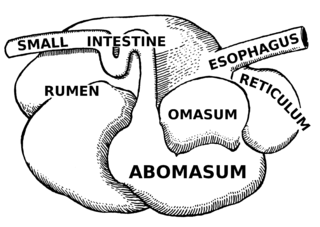
Ruminants are herbivorous mammals of the suborder Ruminantia that are able to acquire nutrients from plant-based food by fermenting it in a specialized stomach prior to digestion, principally through microbial actions. The process, which takes place in the front part of the digestive system and therefore is called foregut fermentation, typically requires the fermented ingesta to be regurgitated and chewed again. The process of rechewing the cud to further break down plant matter and stimulate digestion is called rumination. The word "ruminant" comes from the Latin ruminare, which means "to chew over again".
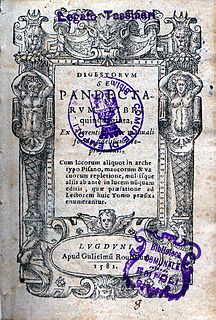
The Digest, also known as the Pandects, is a name given to a compendium or digest of juristic writings on Roman law compiled by order of the Byzantine emperor Justinian I in 530–533 AD. It is divided into 50 books.
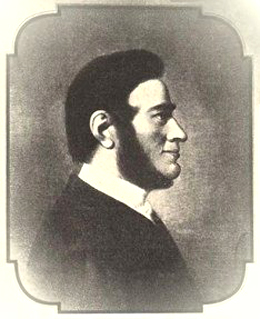
Karel Bořivoj Presl was a Czech botanist.
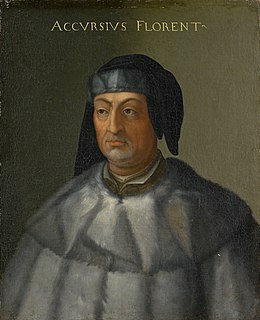
Accursius was a Roman jurist. He is notable for his organization of the glosses, the medieval comments on Justinian's codification of Roman law, the Corpus Juris Civilis. He was not proficient in the classics, but he was called "the Idol of the Jurisconsults".

Species Plantarum is a book by Carl Linnaeus, originally published in 1753, which lists every species of plant known at the time, classified into genera. It is the first work to consistently apply binomial names and was the starting point for the naming of plants.
Gaius Papirius was pontifex maximus in 509 BC, the first year of the Roman Republic. He copied the religious ordinances established by Numa Pompilius, the second King of Rome, which his grandson, Ancus Marcius, had carved on oaken tablets, and placed in the Forum.
The rumen, also known as a paunch, is the largest stomach compartment in ruminants and the larger part of the reticulorumen, which is the first chamber in the alimentary canal of ruminant animals. The rumen's microbial favoring environment allows it to serve as the primary site for microbial fermentation of ingested feed. The smaller part of the reticulorumen is the reticulum, which is fully continuous with the rumen, but differs from it with regard to the texture of its lining.
António Castanheira Neves is a Portuguese legal philosopher and a professor emeritus at the law faculty of the University of Coimbra.
Konrad Eubel or Conradus Eubel was a German Franciscan historian. He is known for his reference work, the Hierarchia Catholica Medii Aevi, on medieval popes, cardinals and bishops. It appeared in three volumes, beginning in 1898. It covers the period 1198 to 1592, and is a more detailed version of the Series episcoporum Ecclesiae Catholicae by Pius Bonifacius Gams.
Lucius Octavius Cornelius Publius Salvius Iulianus Aemilianus, generally referred to as Salvius Julianus, or Julian the Jurist, or simply Julianus, was a well known and respected jurist, public official, and politician who served in the Roman imperial state. Of north African origin, he was active during the long reigns of the emperors Hadrian, Antoninus Pius, and Marcus Aurelius, as well as the shorter reign of Marcus Aurelius' first co-Emperor, Lucius Verus.
Sextus Pedius was a Roman jurist during the late first and early second centuries. He was a contemporary to the Roman Jurists Aulus Ofilius and Massurius Sabinus, and also mentioned in the writings of Pomponius.

Ergovaline is an ergopeptine and one of the ergot alkaloids. It is usually found in endophyte-infected species of grass like Tall fescue or Perennial Ryegrass. It is toxic to cattle feeding on infected grass, probably because it acts as a vasoconstrictor.
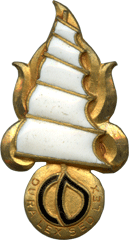
The Disciplinary Company of the Foreign Regiments in the Far East created on June 1 1946, was the disciplinary company for serious offenders from all Foreign Regiments in the Far East. The main Disciplinary Company of the Foreign Legion (CDLE), which received those sent from Legion regiments garrisoned or operating in Algeria, Morocco, Tunisia, the Levant and Tonkin was dissolved on July 1 1964, the latter was based on rules and regulations set by général Rollet in 1931.

Edgeworthia is a genus of plants in the family Thymelaeaceae. When the genus was first described, it was published twice in the same year (1841), in two separate publications: Plantarum vascularium genera: secundum ordines naturales digesta eorumque differentiae et affinitates tabulis diagnostacis expositae; and Denkschriften der Regensburgischen Botanischen Gesellschaft. The genus was named in honour of Michael Pakenham Edgeworth, an Irish-born botanist and official in the Bengal Civil Service, then stationed in India, and for his half-sister, writer Maria Edgeworth.

Pterolophia is a genus of longhorn beetles of the subfamily Lamiinae, containing the following species:

Pterolophia melanura is a species of beetle in the family Cerambycidae. It was described by Francis Polkinghorne Pascoe in 1857. It has a wide distribution in Asia.
Pterolophia gibbosipennis is a species of beetle in the family Cerambycidae. It was described by Maurice Pic in 1926.
Pterolophia instabilis is a species of beetle in the family Cerambycidae. It was described by Per Olof Christopher Aurivillius in 1922. It is known from Seychelles.
Pterolophia guineensis is a species of beetle in the family Cerambycidae. It was described by James Thomson in 1864, originally under the genus Alyattes.









